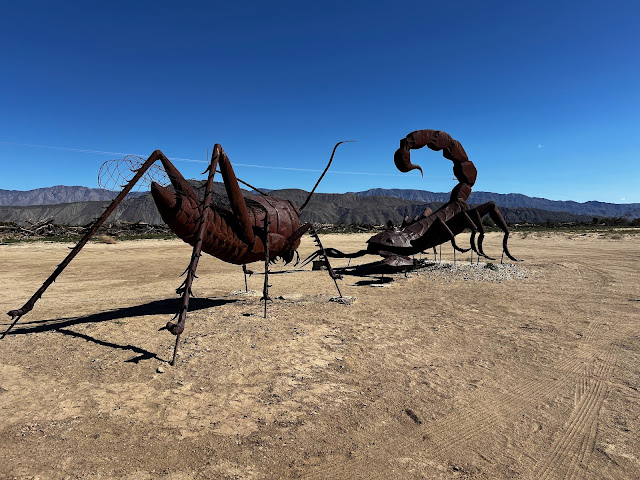Spring is a wonderful time for all gardeners but particularly so for desert gardeners. It is the season of spectacular bloom brought on by winter rains. I have taken advantage of that by adding many blooming plants to my garden to complement the cactus and succulents. Some are perennial and some are annuals like this scarlet flax Linum grandiflorum rubrum. Annuals like to seed themselves along the edge of the paths where they driven by rain. Not always the best place.
Flax are dotted all over the front garden among rocks and cactus. I have always favored growing from seed and finally had success with damianita, Chrysactinia mexicana. This one I grew from seed planted 2 years ago. If I'm not careful it will be crowded out by these penstemon seedlings and a desert marigold. Despite the enormous numbers of seed they produce I have only ever found one growing naturally in my garden. No doubt the fault of the hungry quail who frequent the garden.
Damianita, blackfoot daisy and skullcaps are perfect low-growing perennials for the desert rock garden although not easy to come by. I did manage to find 2 purple skullcaps but unless they are in bloom they are sometimes miss-labeled and turn out to be the more common pink variety. Despite the many flowers and seeds produced it is very difficult to get these three to self-seed.
I'm trying to maintain a good balance of flowers and succulents for the quieter time of year when the cactus are center stage.
The damianita will need to be sheared back soon so they can bloom again when and if the monsoon rains come.
Just coming into bloom is the chocolate daisy, Berlandiera lyrata. I bought one plant 2 years ago and have been able to grow several more plants from seed over the winter. It has always performed well throughout the year opening new flowers every day. It is a morning bloomer, closing its petals by noon. It's chocolaty fragrance cannot be missed when walking around the garden.
This is one of three hedgehog cactus, Echinocereus triglochidiatus, I inherited, which has bloomed successfully each year. Their location is not ideal as they receive sun only in the later parts of the day. A place in a more open spot would probably result in a more spectacular bloom. I have allowed this native cudweed to remain. I love its silvery soft leaves which are the closest we would get to growing lambs ears in the desert. Some call it pearly everlasting as the flowers do well when cut and dried.
My desert marigold, Baileya multiradiata, has become so successful that it threatens to overgrow the driveway. I think it must be getting too much water. It reseeds quite readily where the layers of rock are not too deep or too large.
Spring is a very yellow time of year in the desert and I think I may just have a little too much of it. Between the brittle bush, damianita and the desert marigold I need to find a happier balance. Brittle bush is a wonderful desert plant which also reseeds heavily. I think it is underused as a native plant filling the roadsides with its yellow and dusky sage colored leaves.
Seeds of blanket flowers grown from seed last year have been immensely successful. They are acting as though they are perennial. Last year they bloomed all summer long. You couldn't ask more of a plant in this desert climate.
And there are frequent pop-ups in the spring of native wildflowers like the verbenas.
Verbena gooddingii
The mix of colorful annual, perennials, cactus and succulents is a joy to behold on my early morning stroll around the garden. And it is always early. Spring and summer in the Sonoran desert is a time to get up early to enjoy the cool mornings. The sun rises early and we must make the most of the best part of the day. Now we are in our dry summer with no rains expected until the monsoons arrive in July. Fingers crossed we will get good rains this summer.












.jpeg)






.jpeg)
.jpeg)





.jpeg)

.jpeg)
.jpeg)














.jpeg)





